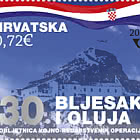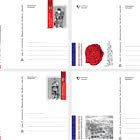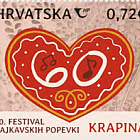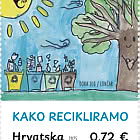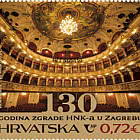Fortified St Nicholas Church – Muster
Fortified churches are at the same time real and metaphorical creations. Real in the sense that by their walls, crenelations, loopholes, and towers they defended not only their own sanctuaries, monasteries, treasures, their memory but also inhabitants of their small communities. Sometimes they were so huge and so well organised (with huge cisterns) that all people from one settlement or one island could have been accommodated within their enclosed space and that they could stand an eventual hostile siege for a long time. Eventual, for often it actually never really occurred, like e.g. the spectacular walls of the town of Dubrovnik never had the chance to play its defensive role. Real danger which the pirates presented for centuries in the areas of Adriatic Croatia, left trace on several fortified churches among which the best known and the biggest are the fortified Church of St Mary of Mercy in Vrboska, on the island of Hvar and the fortified Church of the Holy Spirit on the island of Šipan, both from the third quarter of the 16th century. The impressive fortification iconography has reduced itself in subsequent centuries to the dimensions of baroque cinctors and their function of lovely sacred boundary lines. On the other hand, metaphoric dimension of fortified churches results from the fact that they tell us that the essential protection is God's protection and that the God's temple is the recourse for salvation – not only from earthly dangers but also from those which abduct the soul from eternal life. Fortified St. Nicholas Church in Komiža, on the island of Vis, named also Muster (Monasterium / Monastery), is the oldest representative of its kind in Dalmatia and in whole Croatia. Its two towers, with the north one much later transformed into a bell tower, date from the 13th century. The church was built by the Benedictines who crossed over to Vis from a nearby island of Biševo (where the famous Blue Cave is situated). Inscribed on the lintel, however, is the year DCCCL (850), so that the conclusion can be drawn that the church dates from the 9th century, i.e. from the pre-Romanesque period: with reference to the fact that the whole Mediterranean is a well of time, the presumption is not unfounded. However, the first mention of the church in writing dates from the 12th century or more precisely from 1145, from the deed of donation by the count Peter from Zadar, the ruler of the Middle Dalmatian islands. In 1177 the church was consecrated by the Pope Alexander III, who on his way to Venice found a refuge from bad whether on the islet of Palagruža, and was brought by fishermen to Komiža, wherefrom he continued his journey toward Zadar. The church conserved some of its Romanesque features but was considerably enlarged from the 16th until the end of the 17th century when it was transformed from originally a single nave to five-nave building. Also in the 17th century its defensive set was completed according to Vauban system. Church has followed the destiny of the village which was considered “the most distinctly fishermen’s in character” on the Adriatic coast. After a long period of Venetian rule it came under Austro-Hungarian rule and at the beginning of the 20th century had four thousand inhabitants and seven factories for fish processing. With the fall of Monarchy Komiža also began to stagnate and decay, and the people started to emigrate massively, especially to California. After the Second World War, in the communist Yugoslavia, the whole island of Vis became military area, which prevented its development for long decades. With Croatia becoming independent the fish processing was brought to an end but the prospects of tourism increased. Komiža numbers presently about one thousand and five hundred inhabitants. The St. Nicholas Church has persistently safeguarded its treasures, paintings, goldsmithery and rich library, but it particularly subsisted as the burial church in which many distinguished people from the history of Vis - both common citizens and noblemen found their final rest. On its cemetery recently one of the greatest Croatian writers of the 20th century, Ranko Marinković was buried. Former defensive tower remained as the tower of memory. St. Nicholas, the titular of the church, is the patron of travellers, seamen and fishermen. On his holiday, on 6 December, the inhabitants of Komiža bring in their hands an old wooden, worn out vessel in front of the church. A typical and special vessel from Komiža is falkuša, a genuine and recently in the world known and admired Croatian contribution to the history of Mediterranean shipbuilding. This vessel is burned in thousands of sparkles, it is a sacrifice made to the holy patron, a pawn of renewal, a sign of gratitude and a prayer for new life. Ancient ritual in front of the ancient church is one of the most touching acts which preserve a millennium old Mediterranean tradition. Because the fortress are not just towers or walls. The fortress are human hearts and that which dwells in them and which does not disappear with the last single beat but is further passed down.
The Fortified Church in Cristian, Brasov County, Romania
Mentioned in 1362 in a document belonging to the chancellery of Louis of Anjou, Cristian village dates back in the early 13th century, when Germanic noble people came to settle in the area, and takes pride in the Saxon church, known as the Evangelical Church in Cristian. Declared a historical monument, the church in Cristian was built in the second half of the 13th century, in a period when early Gothic style, under the influence of the Cistercian Monastery in Carta, made its presence felt in the architecture of Transylvania. The old church, dedicated to St. Nicholas, was demolished in 1839. The present church was consecrated in 1841, and follows the model of the church hall equipped with large galleries. In 1903, the tower was heightened with a floor and equipped with a high roof with four turrets at each corner and a platform at the top. The church's interior impresses through its decorative elements: the altar with the statue of Jesus (1868) and the classical pulpit (1881), the giant 50-lamp chandelier with multilevel circles, the stained glass windows in the choir, flanking the altar, the symbolic sculptures in stone and the 2-keyboard organ from 1842. The statue, made by sculptor Johann Bartel, is a copy of a statue carved in wood by the Danish sculptor Bertel Thorwaldsen. Judging after the oval form of the fortified enclosure, the building works of the church establishment started in the late 13th century, and continued until the 18th century; the establishment consisted of an inside fortification wall reinforced by 9 towers of defense, at the time there was also a wide moat around, and in the yard wooden houses were built, being connected with the fortification walls. The goal of the latter was to house residents and provide supplies. In the tower, there are 4 steel bells cast between 1903-1926. In the first decades of the 19th century, the Evangelical cemetery was built, dating back to 1826. In fact, in the 19th century, the enlargement of the church takes place, Neoclassical elements specific to Transylvania being also introduced. After 1700, the church loses its defensive military role, and in the 19th century, the gate bastion is transformed in rectory, the present rectory being built at the beginning of the 20th century. Daniela Bacheş









